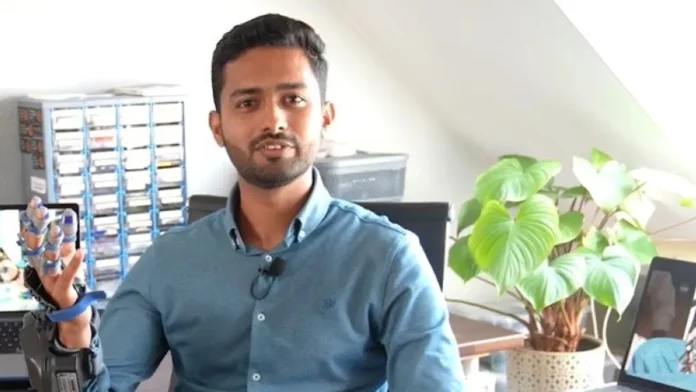Couldn't find anything in ether Google or Google Scholar on this, so no clue on how it works or efficacy. Does it open fingers with spasticity?
Mohammad with his rehabilitation device in the race for national prize
The company Osind Medi Tech of Nuenen citizen Mohammad Samheel has been nominated by health insurer VGZ as ”healthcare innovator of the future’. Specifically, it concerns the Hand in Motion, a rehabilitation device designed by Samheel to help people try to regain their hand function.
Biomedical engineer Samheel talks about the Hand in Motion: “This device was developed for use in arm and hand rehabilitation, for example after a stroke, and is based on intensive, task-oriented training. Patients can do their exercises while the therapist watches remotely. The Hand in Motion makes the rehabilitation process accessible and affordable”.
Samheel was born in India, but now lives with his Dutch wife and their son in Nuenen. “After graduating, I specifically focused on the rehabilitation of hand function, which is crucial for the independence of someone who is rehabilitating. In India, I founded my company Osind Medi Tech, which then moved to the Netherlands. When I approached institutions with my invention, the reactions were immediately enthusiastic. Rehabilitation clinics throughout the Netherlands were interested”.
Helping
For Samheel, it was a kind of ‘return to the past’. During his studies, orthopedists from the hospital he was in contact with asked if he wanted to help them with the rehabilitation of patients who had undergone surgery for a nerve disorder of the hand or tendon or because of a bone fracture. “There are devices for sale that help the patient make the hand movements that are necessary for rehabilitation. But these devices are unaffordable for most hospitals in India”.
And if they are available and break, they often cannot be repaired. Samheel: “So healthcare professionals (occupational therapists and physiotherapists) and interns are deployed to practice the necessary hand movements with the patient for an hour a day. Stretching and bending fingers: a simple exercise that requires a lot of valuable time from these healthcare professionals. There are simply many patients in India who need the help of an occupational therapist or physiotherapist”.
Prototype
The orthopedists asked Samheel if he could design a device that could take over the work of these healthcare professionals and that was accessible to many people. “So something had to be affordable and easy to use. It also had to be suitable for home use, because these patients cannot stay in hospital for a long time”. In collaboration with students from other studies, Samheel succeeded in making a prototype of the Hand in Motion in a short time.
With the acquisition of an international subsidy, the development of the rehabilitation device gained momentum. The Hand in Motion was further improved and made suitable for more applications. “The device now helps with bending, stretching, pinching and grasping(NO extension) and can be fully customised”, Samheel, who now runs his company from the Netherlands, says.
Cash prize
Health insurer VGZ, which organises annual elections for innovative healthcare inventions, got wind of Samheel’s invention. And now he has been nominated in the category ‘Zorgvernieuwer van de toekomst’. He has a chance to win a cash prize of €5,000 to further develop his product and further distribute Hand In Motion throughout healthcare in the Netherlands.
Until 26 September, everyone in the Netherlands can vote online via the VGZ website. The result is determined half by the votes and half by a professional jury. The award ceremony will take place during a final evening on 1 October at the VGZ head office in Arnhem.
For more information : Over Samen Voorop Awards | Coöperatie VGZ | VGZ Zorgverzekering
Source: Studio040

No comments:
Post a Comment